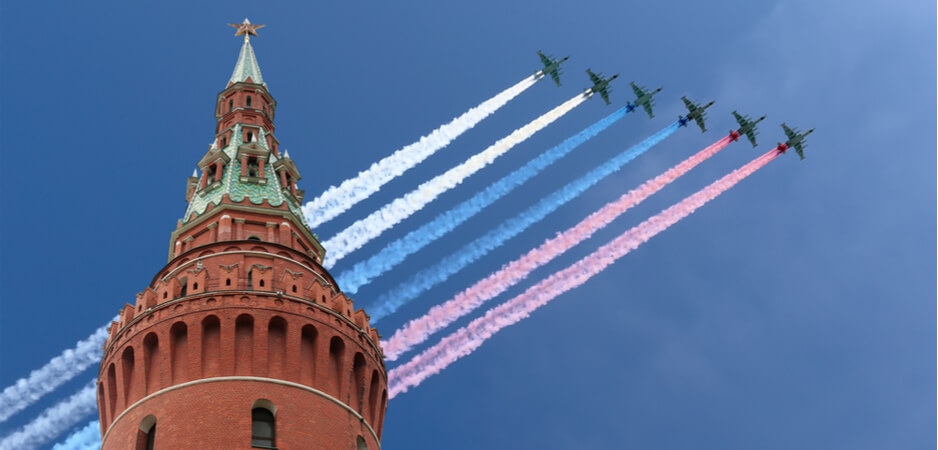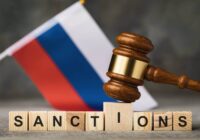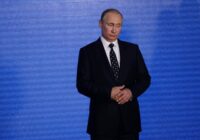With the MENA region quickly becoming Russia’s most profitable destination in terms of exporting arms, the correlation of foreign policy interests is clear.
Involved in armed conflicts on two fronts, in eastern Ukraine and Syria, the Russian Federation’s dual campaigns are often closely associated with one another. Experts looking at Russia’s ongoing operations in the Syrian Civil War often attempt to link them to the conflict in Ukraine. In doing so, analysts and policymakers may inadvertently fail to see the full range of consequences the renewed Russian presence in the Middle East brings. This in no way implies a lack of relationship between the two, but rather that the economic and political benefits Moscow is reaping should be appreciated before such a causal relationship can be understood.
Two main factors of Russia’s intervention in Syria will affect future calculi between interlocutors attempting to resolve the war in the Donbas region and the illegal annexation of Crimea. The first factor that needs addressing is the near-term consequences. Because of its military cooperation with Bashar al-Assad’s regime and other regional players, Moscow has managed to secure billions of dollars from states in the Middle East such as Iran, Saudi Arabia and the United Arab Emirates. Along with rising global oil prices, Russia has further insulated itself against Western sanctions.
The second implication is the geopolitical importance of Russia’s growing presence in the region, which it is utilizing to cast influence throughout the Middle East and North Africa (MENA). Its significance comes in the shape of a favorable bargaining position within and without the Minsk framework (for the resolution of the conflict in eastern Ukraine) for two reasons: geoeconomic clout vis-à-vis the energy market and political leverage over the European Union as it attempts to manage issues related to immigration flows from the MENA region.
Inextricably Linked
September 30, 2015, marked the beginning of Russia’s official involvement in Syria at the request of President Assad, opening with airstrikes around the cities of Homs and Hama in western Syria against the mainstream opposition forces. With the war in eastern Ukraine already being waged for over a year at that point, the two conflicts have since been inextricably linked. Some analysts posit that Russia’s incursion into Syria serves the same purpose as prior aggressions in Ukraine, namely dismantling the current Western-led world order that has been in place since World War II.
Concerning this link, Russia’s President Vladimir Putin likely knew he would be able to use any gains in the Middle East in his favor concerning Ukraine. However, these gains, when seen through a wider lens than just the regional context of Ukraine, provide a clearer analysis of the economically and geopolitically revitalized bargaining position given to the Kremlin on issues with transatlantic partners writ large and, therefore, certainly concerning Donbas and Crimea.
Throughout 2014, as US and EU sanctions began to accumulate, the ruble was at one point devalued by roughly 50%. While Moscow has reclaimed some economic stability, the strength of the Russian currency, which is currently priced at 65 against the US dollar, is no where near its former status of around 35 rubles against the dollar.
While sanctions have certainly hurt Russia’s economy, the drop in the global oil prices had a much more significant effect. Russia’s long-term budget projections placed oil above $100 per barrel; however, at certain points in 2016, the price fell below $30. Moscow’s economic difficulties were further compounded by the budgetary pressures self-imposed by its activities in Ukraine, as well as the economic shock experienced during the 2008-09 global financial crisis that drained central reserves. Even if the sanctions were never imposed, some suggest the Kremlin would still have found itself in a difficult position.
Irrespective of sanctions staying in place, last year the State Duma reviewed the federal budget and projected a surplus of 0.5% of GDP, equating to around $7.7 billion. This was the first expected surplus since 2011, which displays the preponderant effect of oil over Western sanctions given that 2012 marked the beginning of a drop in global oil prices. The World Bank confirmed such reports, forecasting 1.5% GDP growth in 2018, followed by an increase of 1.8% from 2019-20.
Entering Syria
Although the financial losses due to sanctions have not had the same effect as declining oil prices, they have certainly taken their toll. Resumed business with the EU and the US would be the best-case scenario for Russia. However, this would only begin to be a possibility after the Kremlin put forth a concerted effort to work with the international community to bring about peace in the region.
Moscow, however, understands that an abrupt end to the fighting in Donbas, in which it has only marginally admitted involvement, would be highly unlikely, especially while trying to save face on both the international stage as well as in front of domestic audiences. Given this reality, Russia appears fully committed to increasing relations in the Middle East not only militarily, but also economically, as part of its eastward pivot toward the MENA region and Asia.
Important to note is that on the list of sanctioned individuals and entities is Vnesheconombank (VEB), of which Russia’s sovereign wealth fund (SWF), the Russian Direct Investment Fund (RDIF), is a fully owned subsidiary. Put simply, SWFs serve as state-owned instruments in public finance. Largely funded by revenues from commodity exports or from foreign exchange reserves in a state’s central bank, SWFs may be used to invest globally. As such, Russia has begun to circumvent the economic hardship of sanctions and severed business partnerships in the West by contractually binding itself to other sovereign wealth funds in the Middle East.
While not an exhaustive list of SWF partnerships, the following are the most lucrative of contracts set up through the RDIF, which represent short-term financial reprieve and long-term economic bargaining power for the Kremlin: the Qatari Investment Authority has committed over $2.5 billion in assets to Russia, mostly within Russia’s oil giant Rosneft; Saudi Arabia’s Public Investment Fund invested $10 billion, mostly focused on technology and energy; and Abu Dhabi, for its part, has set up a $3 billion fund with the RDIF, focused on developing Russia’s southern infrastructure and agricultural sectors.
Arms Sales
Apart from direct SWF investment, Russia’s arms industry has also received a huge boon since Russia commenced military operations in Syria. The importance of this can be seen from former deputy prime minister, Dmitry Rogozin, stating that “arms sales are the most important element of Moscow’s relations with other countries.” For example, in 2009 Moscow sold roughly $9 billion in arms to the MENA region. In 2016, that number rose to $21.4 billion. With the MENA region quickly becoming Russia’s most profitable destination in terms of exporting arms, behind Asia, the correlation of foreign policy interests is clear.
The Kremlin has used the war as effective advertising from the very beginning. In early October, shortly after Russia officially entered the war on behalf of Assad’s regime, Moscow fired 26 cruise missiles from its Caspian Sea flotilla, hitting various targets in Syria. Although it could be argued that the same objective could have been carried out through military capabilities already in-country, Russia was able to broadcast its new technology on a global scale.
Shortly after, customers from the Middle East and abroad began to line up to buy various weapons systems. The key example of this success would be Tehran resuming its position as a top-tier client following the 2015 Joint Comprehensive Plan of Action (and Russia’s assistance in the process) placing weapon orders to the sum of $10 billion.
For the near future, any economic gains achieved by the Russian Federation may directly affect its position moving forward concerning Ukraine. The Kremlin has been hemorrhaging money in backing separatist activities and financing its own operations in Donbas and Crimea. Arms sales and economic partnerships in the Middle East and North Africa will provide the monetary reprieve Russia needs to shield itself from the financial backlash currently being sustained.
Long-Term Benefits
While economic deals amongst SWFs and recent increases in arms sales provide Russia assistance in the near-term to face the previous shock to global oil prices as well as Western sanctions, the mid to long-term implications of Russia’s involvement in the Syrian Civil War are the most important to analyze. In terms of bilateral cooperation in the Middle East, relations with Iran are the most important for Russia. A major consumer of Russian arms, Moscow sees Tehran as a “regional superpower” given Iran’s extensive involvement in the war in Syria, its support for Hamas and Hezbollah, as well as the question of its future nuclear capabilities.
Russia also views Tehran as a reliable partner with whom it can successfully counter the US presence in the Black Sea, the Caspian region and the Middle East, in addition to controlling Sunni extremism within Russia’s near-abroad — the North Caucasus and Central Asia. While the war in Syria will eventually come to an end, Russia has now successfully locked itself into the region through its access to the Syrian port of Tartus and the Khmeimim airbase, which it will maintain for at least the next 48 years.
The geopolitical importance of Russia’s permanent military presence in the region, in concert with growing forms of economic cooperation, may be better realized through discussion of the north-south corridor. Introduced by President Putin in 2007, this strategic initiative is based upon a mixture of financial planning and political enterprise. Moscow’s goal with the so-called north-south corridor is to utilize its partnerships in the Middle East and create a staging ground for further economic and political cooperation in Africa and the “global south.”
 One example of this is a deal likely brokered thanks to SWF investments in Abu Dhabi’s defense sector for Moscow to create an air hub in the UAE. Through this hub, Russia will be able to deliver infrastructure projects and humanitarian aid.
One example of this is a deal likely brokered thanks to SWF investments in Abu Dhabi’s defense sector for Moscow to create an air hub in the UAE. Through this hub, Russia will be able to deliver infrastructure projects and humanitarian aid.
Should Russia continue to gain political clout throughout the MENA region, the European Union may find itself dealing with Russia as its main interlocutor for issues such as the ongoing refugee crisis. In many European countries, issues concerning migration flows are dominating the discourse in the media and political spheres. Domestic political concerns will likely take precedence over the war in Ukraine. Therefore, Russia’s ability to provide concessions — for example through growing its influence in Libya — to work with the EU in dealing with migration may, in turn, lead to unfavorable tradeoffs for Ukraine.
The trends regarding military and economic cooperation between Russia and its Middle Eastern partners may have begun well before the annexation of Crimea. However, it is apparent that Western sanctions and political pressure have since driven the Kremlin farther east, accelerating its efforts. This divergence does not appear to be coming solely out of desperation after the loss of Western investment, but rather because of the real promise Moscow sees in its increasingly eastward-leaning strategic focus.
Russia’s enlarged presence in the Middle East, particularly as it relates to renewed ties with Iran and the potential access this will give the Kremlin to developments in Africa, clearly displays the war in Syria as just the beginning.
Any increased influence in these regions will come at the expense of transatlantic partners and will shift bargaining positions when it comes to its dealings with Russia, namely as it pertains to Ukraine. If these trends persist, in addition to rising oil prices, some rethinking will be required when it comes to countering Russia in Ukraine as sanctions may become less and less relevant. If this is the case, expect the Russian Federation to become economically more viable, geographically more influential and, as a result, perhaps more aggressive in eastern Ukraine.
The views expressed in this article are the author’s own and do not necessarily reflect Fair Observer’s editorial policy.
Support Fair Observer
We rely on your support for our independence, diversity and quality.
For more than 10 years, Fair Observer has been free, fair and independent. No billionaire owns us, no advertisers control us. We are a reader-supported nonprofit. Unlike many other publications, we keep our content free for readers regardless of where they live or whether they can afford to pay. We have no paywalls and no ads.
In the post-truth era of fake news, echo chambers and filter bubbles, we publish a plurality of perspectives from around the world. Anyone can publish with us, but everyone goes through a rigorous editorial process. So, you get fact-checked, well-reasoned content instead of noise.
We publish 2,500+ voices from 90+ countries. We also conduct education and training programs
on subjects ranging from digital media and journalism to writing and critical thinking. This
doesn’t come cheap. Servers, editors, trainers and web developers cost
money.
Please consider supporting us on a regular basis as a recurring donor or a
sustaining member.
Will you support FO’s journalism?
We rely on your support for our independence, diversity and quality.






